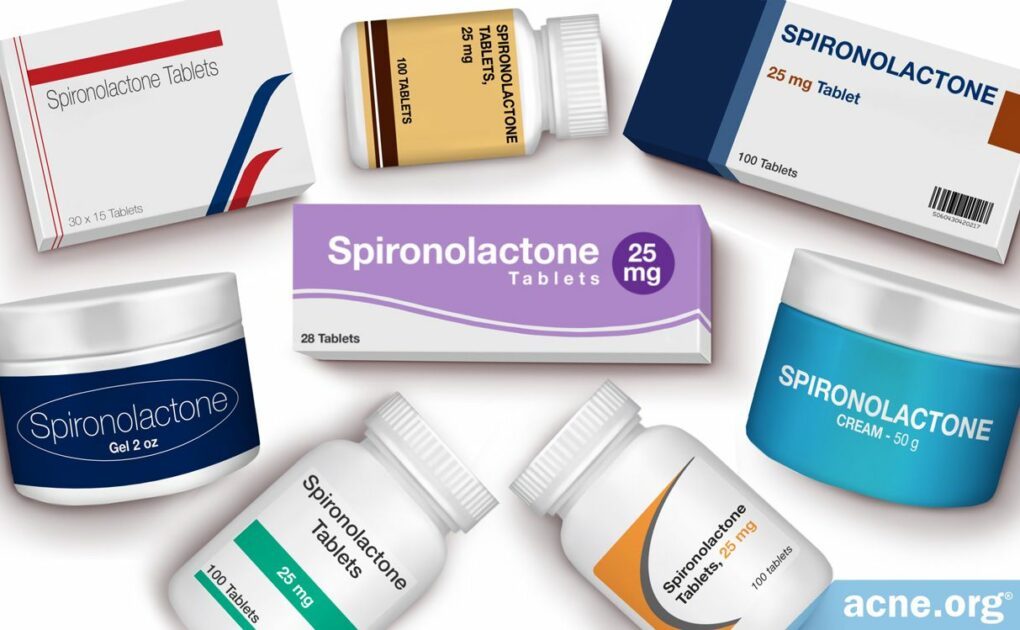Spironolactone Is an Anti-androgen Medication That May Be Somewhat Effective for Females

The Essential Info
Spironolactone is an oral medication prescribed almost always to females that suppresses the production of androgens (male hormones found in both males and females). Higher levels of male hormones in both males and females lead to more skin oil production, and in turn, more acne. Spironolactone reduces male hormone levels, thus decreasing skin oil production and ultimately decreasing acne symptoms.
Studies show that spironolactone is at least moderately effective at reducing acne when taken for 3 months or more, and that results continue to improve over time while taking the medication.
Spironolactone is almost always prescribed to females because it can cause feminizing effects, such as breast growth, when taken by males. Doctors normally prescribe it to female patients along with the birth control pill.
Because spironolactone is an oral medication that affects hormones, side effects are numerous and widespread. The most common side effect is menstrual irregularities such as increased or decreased bleeding or breakthrough bleeding (bleeding between periods). Menstrual side effects can be reduced by taking spironolactone with a combined oral contraceptive (COC).
Rebound Acne: We have no research looking at whether acne will rebound after you stop taking spironolactone, and if so, for how long this rebound acne might persist. Anecdotally, some women report that their acne gets worse than ever after stopping spironolactone, but it’s hard to say whether these might be rare exceptions.
Be Careful: Any time you’re interfering with your natural hormone levels, you’re opening the door to wide-ranging effects on your entire body. Sometimes, the benefits of hormonal therapy outweigh the risks, but it’s not something to be dismissed lightly. Exercise caution before embarking on any type of hormonal therapy.
Important Note for Pregnant or Lactating Women: Because spironolactone may cause birth defects, women who are pregnant or may become pregnant should not take it, and should exercise caution while breastfeeding as well.
Topical Spironolactone: Researchers have also studied spironolactone topically, and results thus far show that it can also help with acne, albeit most likely to a lesser extent when compared with oral spironolactone. Because it is administered only on top of the skin and not orally, topical spironolactone may also be a possible treatment for males, but more research is still needed to make sure it is safe.

The Science
- Oral Spironolactone Is Moderately Effective in Treating Acne
- Topical Spironolactone Appears to Also Be Moderately Effective in Treating Acne
- What Are the Side Effects of Oral Spironolactone?
- Contraindications
Spironolactone is an oral medication that is primarily used in medicine to treat heart failure and high blood pressure. While it has not been approved by the FDA (U.S. Food and Drug Administration) to treat acne, doctors sometimes prescribe it for that purpose as well. This is called off-label prescribing, and it is a common practice with many medications.1
The reason that doctors prescribe spironolactone to treat acne is that it is an anti-androgen.1 High levels of androgens (male hormones that are present in both males and females) contribute to acne. As a 2014 article in Clinics in Dermatology states, “Androgens play an important role in [skin oil] production and excretion. This subsequently contributes to the formation of acne lesions.”2 Because anti-androgens reduce the amount of androgens in the body, they can help clear up acne lesions.
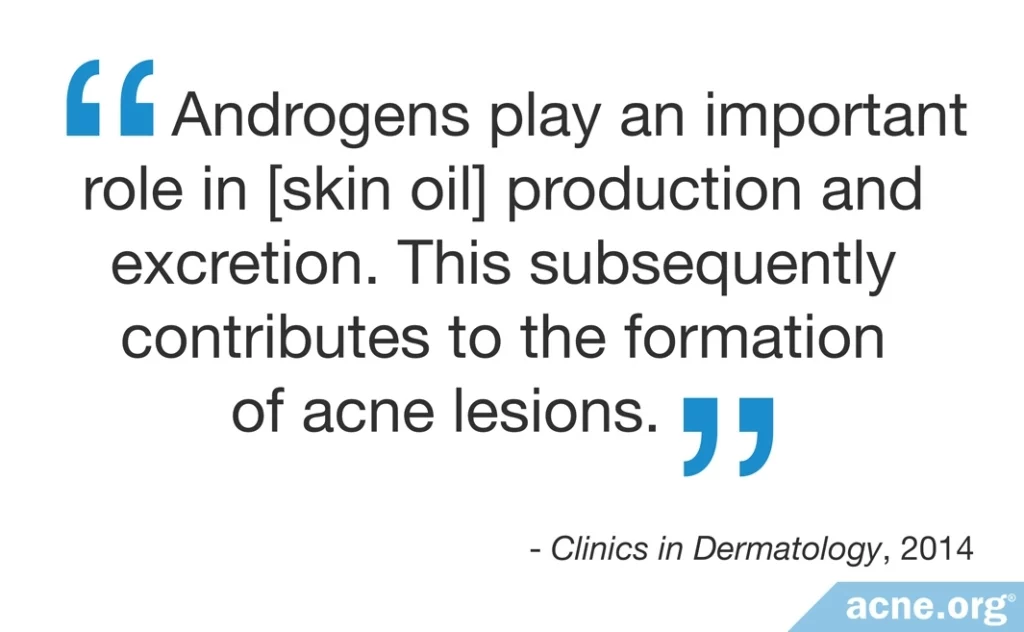
Because spironolactone’s anti-androgen activity can cause undesirable side effects, such as breast enlargement in men, it usually is prescribed only to women when treating acne.
The recommended dosage for acne treatment ranges from 25 – 200 mg per day. Once acne is reduced, the recommended maintenance dosage ranges usually from 25 – 50 mg per day. Researchers recommend starting with a low dose and increasing the dose only if necessary to control acne symptoms.3
Spironolactone usually is prescribed with a combined oral contraceptive (COC), more commonly known as the birth control pill, though it can be taken alone.
Doctors also sometimes combine spironolactone with oral antibiotics. This is controversial since antibiotics produce only moderate benefit and come with a plethora of side effects. However, according to a 2012 review in The Journal of Clinical and Aesthetic Dermatology:

“Spironolactone has been used safely and effectively in combination with oral antibiotics including tetracyclines, erythromycin, and amoxicillin.”3
Oral Spironolactone Is Moderately Effective in Treating Acne
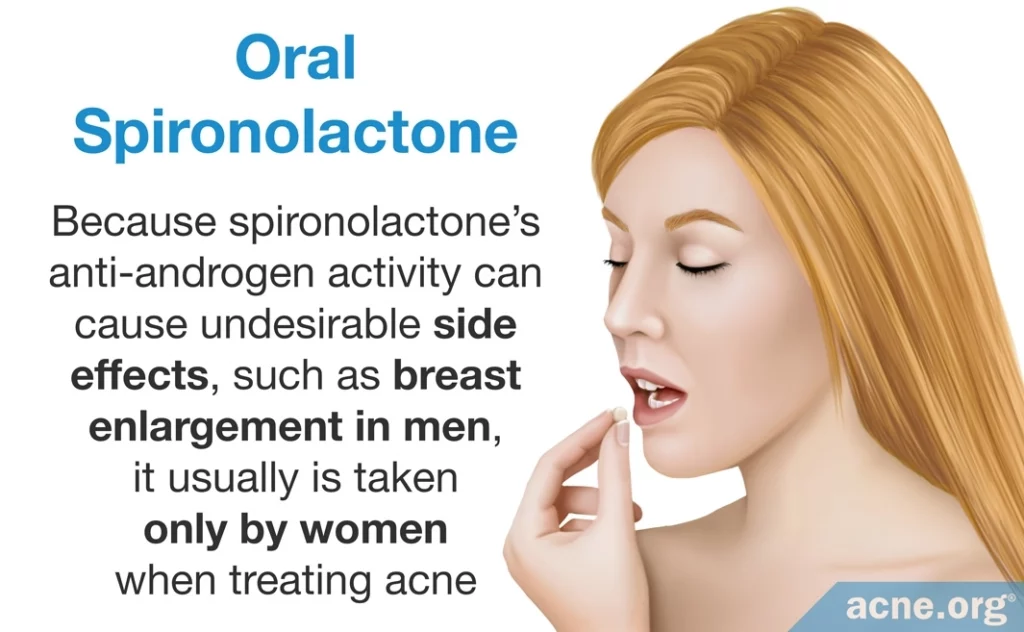
Thirteen studies performed to date indicate that oral spironolactone is at least moderately effective in treating acne. While the studies used different methods and looked at different numbers of patients, the results of each study show at least moderate improvement in acne in the majority of patients.4-16 It should be noted that although 2 of the studies included male patients, doctors almost always prescribe spironolactone only to women.
Expand to read details of studies

A 1984 study in the British Journal of Dermatology investigated the efficacy of spironolactone in both men and women with severe acne. Although the researchers examined men, doctors almost always prescribe spironolactone only to women. They randomly assigned 36 participants (17 men and 19 women) to receive 1 of 5 treatments.
1. 50mg of spironolactone
2. 100mg of spironolactone
3. 150mg of spironolactone
4. 200mg of spironolactone
5. A placebo
This was a double-blind study, meaning that neither the participants nor the researchers knew which treatment each person received. Only 26 of the participants completed the 3-month study, which found that improvement in acne was related to the dosage of spironolactone: 80% of those taking 150 or 200mg experienced improvement in their acne; 60% of those taking 50 or 100mg experienced improvement, and only 10% of those taking the placebo experienced improvement. More than half of the women (58%) had minor side effects, such as menstrual irregularities, but none of the women stopped the study because of this. None of the men experienced enlarged breasts. Overall, this study found that spironolactone significantly improved acne with only minor side effects.4

Researchers in a 1986 study in the same journal gave 21 women 200 mg of spironolactone daily for 3 months. The researchers randomly assigned the women to a treatment group or to a placebo group. This study found that the group taking spironolactone experienced a 66% improvement in the number of acne lesions after 3 months. In contrast, the women in the placebo group did not experience improvement in their acne. Seventy-three percent of the women who did not take a COC also experienced menstrual side effects, but all of the women persisted. Two women dropped out of the study because of nausea.5

A 2000 study in the Journal of the American Academy of Dermatology assessed spironolactone’s effectiveness by looking at the medical records of 85 women with acne who had been treated for a maximum of 24 months with spironolactone in dosages ranging from 50 – 100 mg per day, either alone or alongside other acne treatments. This study found that 33% of the women experienced significant improvement in their acne; 27.4% experienced partial improvement, and only 7% experienced no improvement.6

A 2005 study in the Journal of the European Academy of Dermatology and Venereology looked at the effectiveness and side effects of spironolactone in women with acne. Researchers treated 35 women with 100 mg of spironolactone per day for 16 days each month, which is an unusual dosing pattern, for 3 months. This study found that 85.7% of the women experienced clinically significant improvement in their acne. When considering all of the women, the reduction in acne lesions was 79% after 3 months of treatment. The only side effects that this study mentioned were menstrual irregularities, which half of the women experienced but which resolved within 3 months.7

A 2006 study in Aesthetic Plastic Surgery investigated the effectiveness and safety of spironolactone in Asians. Researchers gave 139 acne patients (116 women and 23 men) 200 mg of spironolactone per day for 8 weeks and then reduced the dosage by 50 mg for every 4 weeks. The study lasted for 20 weeks total. Three of the men developed enlarged breasts, so the researchers stopped the treatment in all men. Eighty percent of the women experienced menstrual irregularities, and some dropped out consequently. Only 64 of the women completed the study. Of these, 53% of the women rated their acne improvement as excellent, and 47% rated their improvement as good. Overall, the treatment was less effective in men than in women.8

A 2008 study in the Journal of the American Academy of Dermatology investigated the effectiveness and safety of a combination treatment consisting of spironolactone and a COC in 27 women with severe facial acne. Researchers treated the women with 100 mg of spironolactone and the COC for 6 months. All women tolerated both treatments well, with minimal or no side effects. After 6 months, 11% of the women were free of acne; 74% experienced significant improvement, and 7.4% experienced some improvement.9

A 2017 study in the journal Dermatology looked through medical records over a period of 4 years and found 400 female patients who had received spironolactone for their acne. The researchers concluded that 86% of the female patients experienced an improvement in their acne while on spironolactone therapy. The authors wrote, “Further, patients who improved showed minimal side effects, supporting recent evidence that spironolactone is a safe option for acne treatment with a low risk of short-term adverse effects.” However, the researchers noted some limitations of the study, such as short periods of follow-up with some of the patients.10

A 2017 study published in the European Journal of Dermatology also looked back through the medical records of females treated with spironolactone. The researchers found 70 women with acne who took up to 150 mg of spironolactone daily for an average of 6 months. The scientists found that in 71% of the women, acne improved on spironolactone. They wrote, “This retrospective data analysis confirms that the use of low doses of spironolactone is a valuable alternative in women with acne in whom oral isotretinoin has failed.”11

A 2017 study in the International Journal of Women’s Dermatology likewise used past medical records to see how effective spironolactone was at controlling acne. In this study, 94 out of 110 female patients, or 85%, showed an improvement in acne after taking spironolactone. In fact, 55% of the patients experienced a complete clearing of their acne. On average, the women reported an improvement of 73.1% for the face, 75.9% for the chest, and 77.6% for the back. Although 51 women experienced side effects, only 6 women stopped treatment because of the side effects. The researchers wrote, “A majority of women in this study saw a dramatic improvement in their acne while treated with spironolactone. There were low rates of relapse or discontinuation of the medication.”12

In 2020, The Journal of Dermatology published the results of a clinical trial that tested low-dose spironolactone together with topical benzoyl peroxide on female patients with acne. The trial was double-blinded and included 63 women aged 25–45 years. The participants were divided into 3 groups:
- Group 1 took a placebo pill (a drug that looked the same as spironolactone but did not contain any active ingredient) once a day + applied 2.5% benzoyl peroxide to the skin once a day for 12 weeks.
- Group 2 took 25 mg of spironolactone once a day + applied 2.5% benzoyl peroxide to the skin once a day for 12 weeks.
- Group 3 took 50 mg of spironolactone once a day + applied 2.5% benzoyl peroxide to the skin once a day for 12 weeks.
At the end of the 12-week period, 30% of patients in Group 1 achieved clear or nearly clear skin, compared to 40% of patients in Group 2 and 75% of patients in Group 3. This suggests that while benzoyl peroxide on its own helped clear acne in about 30% of cases, adding spironolactone to the treatment achieved additional improvement, and the higher dose of spironolactone was much more effective than the lower dose. The scientists concluded that adding 50 mg of spironolactone to a topical benzoyl peroxide treatment regimen can effectively improve acne in female patients without causing serious side effects.13

A study published in 2020 in Pediatric Dermatology analyzed past medical records of 80 female patients between the ages of 14 and 20 who had taken 100 mg of spironolactone daily for at least 3 months. The majority of patients (80%) experienced an improvement in acne, with 22.5% achieving clear skin and 58.8% achieving nearly clear skin. However, most of the patients who improved on spironolactone treatment were taking oral contraceptives at the same time. Therefore, it is unclear how much spironolactone itself contributed to the results. Only 22 patients, or approximately one quarter, achieved significant improvement in their acne by taking spironolactone alone. The researchers concluded that a daily dose of 100 mg of spironolactone may be effective for teen females for whom other oral medications haven’t worked, and might be a helpful addition for patients who are already taking oral contraceptives.14

In 2021, the Journal of the American Academy of Dermatology published a similar study in which researchers looked through past medical records of 403 female patients who had taken spironolactone for acne. For most of the patients, the starting dose was 100 mg of spironolactone taken once a day, and the course of treatment lasted around 1 year and 3 months on average. Acne improved in 75% of the patients, with results accumulating over time. After 6 months of treatment, 20% of patients had achieved clear skin, compared to 40% after 9 months, and over 50% after 1 year. The researchers concluded that long-term use of spironolactone improves acne in women.15
It is important to keep in mind that some of the patients in these studies were taking other medications in addition to spironolactone, such as oral contraceptives, benzoyl peroxide, and antibiotics. This makes it difficult to be sure that spironolactone was responsible for the improvement. Therefore, the researchers noted the need for more controlled studies testing spironolactone on new patients rather than using past medical records.

A 2017 article published in the American Journal of Clinical Dermatology reviewed all available high-quality evidence on spironolactone and acne. The authors analyzed 10 randomized controlled trials, which offer rigorous evidence, and 21 case series, which are lower-quality scientific reports. The researchers concluded that all these studies, even the randomized controlled trials, had a high risk of bias. This means that the results of the studies might be over-optimistic about how well spironolactone works for women with acne.16
Still, the scientists found low-quality evidence that 200 mg of spironolactone a day effectively reduces the number of inflammatory acne lesions. They also concluded that menstrual irregularities, which are an occasional side effect of spironolactone, depend on the dose and can be decreased by taking combined oral contraceptives (birth control pills that contain estrogen and progesterone) at the same time.16

Topical Spironolactone Appears to Also Be Moderately Effective in Treating Acne

Spironolactone is almost always prescribed for acne in its oral form but is also available in topical form.
We have 4 studies that examine the effectiveness of topical spironolactone for treating acne, and it appears to also be at least somewhat effective. When used topically, spironolactone causes fewer and less severe side effects compared with taking it orally. Also, it may be safe for males to use spironolactone topically, whereas it is not recommended for males to take oral spironolactone.
The first, an Italian study, found that 1 month of treatment with topical spironolactone either cleared or significantly improved acne in the vast majority of patients.17 The second study found that 6 weeks of treatment with topical spironolactone decreased the number of acne lesions by 71%.18 The third study reported that 8 weeks of treatment with spironolactone cream significantly decreased the number of acne lesions in both males and females.19 Finally, the fourth study compared the efficacy of topical spironolactone against a topical antibiotic, clindamycin. After 12 weeks of treatment, spironolactone resulted in a greater improvement in acne than clindamycin.20
Expand to read details of studies
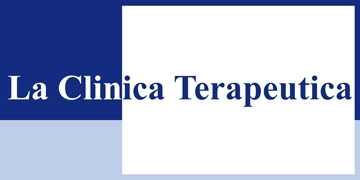
A 1990 study in the Italian journal, La Clinica Terapeutica, evaluated the effectiveness of a 5% spironolactone preparation for 1 month in 20 patients (9 females and 11 males). This study found that acne cleared in 30% of the patients and improved in 65%. The participants did not report side effects.17

A 2012 study in the Journal of Dermatological Treatment compared the effectiveness of a 5% spironolactone gel with that of a placebo. The researchers randomly assigned 78 patients with mild to moderate acne to either a treatment group (30 females and 8 males) or a placebo group (34 females and 6 males). Participants applied the medication twice per day for 6 weeks, leaving the medication on the acne lesions for 2 to 3 hours each time before washing it off. After 6 weeks, the total number of acne lesions in the treatment group decreased by 71%, compared to only 36% in the placebo group.18

A 2021 study in the journal Health Science Reports tested a 5% spironolactone cream on patients with mild-to-moderate acne. This preliminary study included 15 patients (10 females and 5 males) who used spironolactone cream twice a day for 8 weeks. The researchers found that that this treatment regimen decreased the number of acne lesions, including whiteheads, blackheads, and papules, in both males and females.19 However, since the study was very small and lacked a control group (a group of patients who did not use spironolactone for comparison), we must be cautious in drawing conclusions about the efficacy of spironolactone cream.

Another 2021 study published in the journal Cureus tested a topical spironolactone solution on patients with acne. The study included 68 patients (51 females and 17 males) divided into 2 groups:
- Group 1 used a 2% spironolactone solution twice a day for 12 weeks.
- Group 2 used a 1.5% clindamycin (antibiotic) solution twice a day for 12 weeks.
At the end of the treatment period, the researchers found that the spironolactone solution was significantly better than the clindamycin solution at reducing the number of whiteheads, blackheads, and pustules, while both were about equally effective at reducing the number of papules. Overall, acne was more improved and patients were more satisfied with the topical spironolactone than the topical clindamycin treatment.20

When it comes to side effects, the evidence suggests that topical spironolactone causes fewer side effects than the oral version of the medication. This makes sense, as the topical medication is only affecting the skin at the application site, with very little of it, if any, being absorbed into the bloodstream. A 2023 review, which analyzed 4 studies on topical spironolactone, concluded that it caused no systemic, or whole-body, side effects. In particular, no patients reported headaches, dizziness, unwanted facial hair growth, enlarged or painful breasts, menstrual irregularity, or decreased sex drive, all of which are systemic side effects that can potentially occur with hormonal medications. Since the studies included male patients, this is promising evidence that topical spironolactone may be a safe option for males with acne.21 However, more studies with larger numbers of patients are needed to confirm this. For now, topical spironolactone remains a rarely-prescribed acne treatment.22
What Are the Side Effects of Oral Spironolactone?
As with all medications, oral spironolactone can cause side effects, particularly at higher doses. Most people tolerate low doses of spironolactone well, even for long periods of time. Side effects that can occur at dosages higher than 100mg per day include:
- Menstrual irregularities, such as increased or decreased menstrual bleeding or breakthrough bleeding, which is bleeding that occurs between periods. Adding a COC to the treatment reduces these side effects.
- Tenderness or enlargement of the breasts in both males and females. Adding a COC to the treatment can reduce this side effect.
- Orthostatic hypotension, which is a sudden drop in blood pressure when standing up that can result in dizziness or fainting.
- Reduced libido (sex drive).
- Excessively high potassium level in the blood. This is a dangerous side effect that can cause life-threatening heart problems. However, it is not common in healthy young people. Because of this side effect, people with kidney problems should not use spironolactone. In addition, spironolactone cannot be used with certain medications, including diuretics (medications that increase urination and can result in too much potassium in the blood) and ACE inhibitors, which often are used for high blood pressure.3
Side effects that do not seem to be related to dose include:
- Tiredness
- Headache
- Lightheadedness
- Dizziness3
Spironolactone can also come with these other side effects:
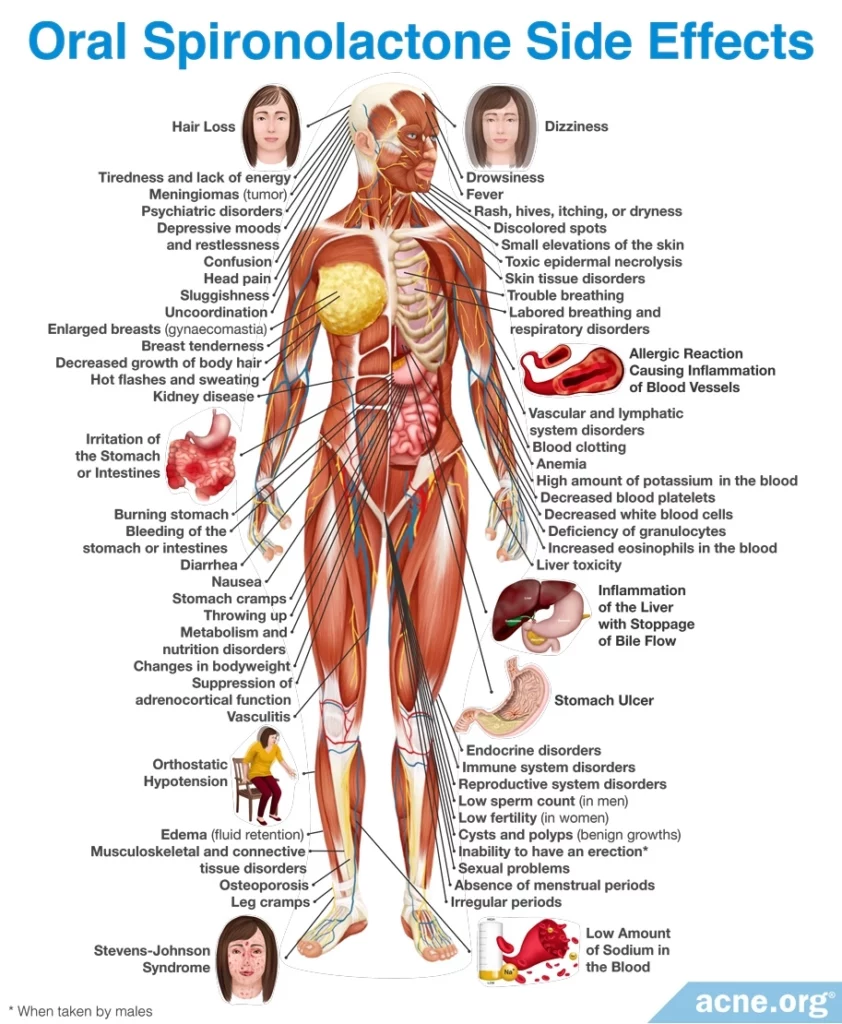
Contraindications
Males should not take spironolactone because it can cause side effects related to its anti-androgen effects. These include impotence, enlarged breasts, and loss of libido.
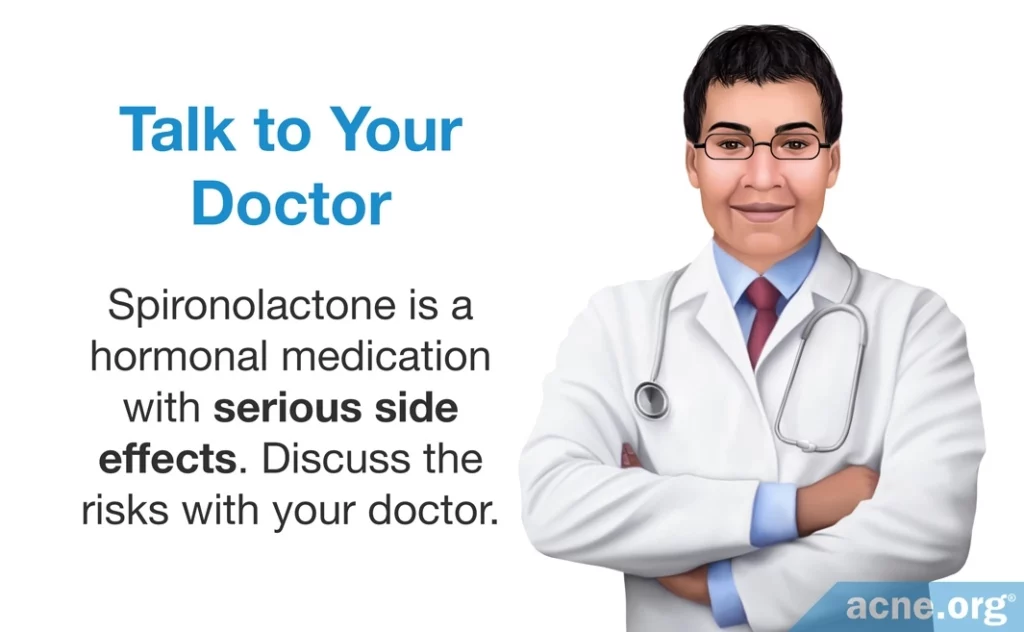
Women who are pregnant or may become pregnant should not take spironolactone because it can cause birth defects, especially feminization of a male fetus. This is one reason that spironolactone often is prescribed with a COC.3
While the American Academy of Pediatrics classifies spironolactone as “probably compatible” with breastfeeding, women who are breastfeeding should carefully approach the decision to take spironolactone.3
References
- Zaenglein, A. L. et al. Guidelines of care for the management of acne vulgaris. J. Am. Acad. Dermatol. 74, 945 – 973 (2016). https://www.ncbi.nlm.nih.gov/pubmed/26897386
- Lam, C. L. & Zaenglein, A. L. Contraceptive use in acne. Clin. Dermatol. 32, 502 – 515 (2014). https://www.researchgate.net/publication/263857122_Contraceptive_use_in_acne
- Kim, G. K. & Del Rosso, J. Q. Oral spironolactone in post-teenage femal patients with acne vulgaris. J. Clin. Aesthet. Dermatol. 5, 37 – 50 (2012). https://www.ncbi.nlm.nih.gov/pubmed/22468178
- Goodfellow, A. et al. Oral spironolactone improves acne vulgaris and reduces sebum excretion. Br. J. Dermatol. 111, 209 – 214 (1984). https://www.ncbi.nlm.nih.gov/pubmed/6235834
- Muhlemann, M. F., Carter, G. D., Cream, J. J. & Wise, P. Oral spironolactone: an effective treatment for acne vulgaris in women. Br. J. Dermatol. 115, 227 – 232 (1986). https://www.ncbi.nlm.nih.gov/pubmed/2943311
- Shaw, J. C. Low-dose adjunctive spironolactone in the treatment of acne in women: a retrospective analysis of 85 consecutively treated patients. J. Am. Acad. Dermatol. 43, 498 – 502 (2000). https://www.ncbi.nlm.nih.gov/pubmed/10954662
- Yemisci, A., Gorgulu, A. & Piskin, S. Effects and side-effects of spironolactone therapy in women with acne. J. Eur. Acad. Dermatol. Venereol. 19, 163 – 166 (2005). https://www.ncbi.nlm.nih.gov/pubmed/15752283
- Sato, K. et al. Anti-androgenic therapy using oral spironolactone for acne vulgaris in Asians. Aest. Plast. Surg. 30, 689 – 694 (2006). https://www.ncbi.nlm.nih.gov/pubmed/17077951
- Krunic, A., Ciurea, A. & Scheman, A. Efficacy and tolerance of acne treatment using both spironolactone and a combined contraceptive containing drospirenone. J. Am. Acad. Dermatol. 58, 60 – 62 (2008). https://www.ncbi.nlm.nih.gov/pubmed/17964689
- Grandhi, R. & Alikhan, A. Spironolactone for the treatment of acne: A 4-year retrospective study. Dermatology 233, 141 – 144 (2017). https://www.ncbi.nlm.nih.gov/pubmed/28472793
- Isvy-Joubert, A., Nguyen, J. M., Gaultier, A. et al. Adult female acne treated with spironolactone: a retrospective data review of 70 cases. Eur. J. Dermatol. 27, 393 – 398 (2017). https://www.ncbi.nlm.nih.gov/pubmed/28862134
- Charny, J. W., Choi, J. K. & James, W. D. Spironolactone for the treatment of acne in women, a retrospective study of 110 patients. Int. J. Womens Dermatol. 3, 111 – 115 (2017). https://www.ncbi.nlm.nih.gov/pubmed/28560306
- Patiyasikunt, M., Chancheewa, B., Asawanonda, P., Noppakun, N. & Kumtornrut, C. Efficacy and tolerability of low-dose spironolactone and topical benzoyl peroxide in adult female acne: A randomized, double-blind, placebo-controlled trial. J. Dermatol. 47, 1411-1416 (2020). https://pubmed.ncbi.nlm.nih.gov/32857471/
- Roberts, E. E., Nowsheen, S., Davis, D. M. R., Hand, J. L., Tollefson, M. M. & Wetter, D. A. Use of spironolactone to treat acne in adolescent females. Pediatr. Dermatol. 38, 72-76 (2021). https://pubmed.ncbi.nlm.nih.gov/33009838/
- Garg, V., Choi, J. K., James, W. D. & Barbieri, J. S. Long-term use of spironolactone for acne in women: A case series of 403 patients. J. Am. Acad. Dermatol. 84, 1348-1355 (2021). https://pubmed.ncbi.nlm.nih.gov/33434594/
- Layton, A. M., Eady, E. A., Whitehouse, H., Del Rosso, J. Q., Fedorowicz, Z. & van Zuuren, E. J. Oral spironolactone for acne vulgaris in adult females: A hybrid systematic review. Am. J. Clin Dermatol. 18, 169 – 191 (2017). https://www.ncbi.nlm.nih.gov/pubmed/28155090
- Califano, L., Cannavò, S., Siragusa, M. & Girardi, R. [Experience in the therapy of acne with topical administration of spironolactone as an antiandrogen]. Clin. Ter. 135, 193 – 199 (1990). https://www.ncbi.nlm.nih.gov/pubmed/2150020
- Afzali, B. M., Yaghoobi, E., Yaghoobi, R., Bagherani, N. & Dabbagh, M. A. Comparison of the efficacy of 5% topical spironolactone gel and placebo in the treatment of mild and moderate acne vulgaris: a randomized controlled trial. J. Dermatolog. Treat. 23, 21 – 25 (2012). https://www.ncbi.nlm.nih.gov/pubmed/20964565
- Ayatollahi, A., Samadi, A., Bahmanjahromi, A. & Robati, R. M. Efficacy and safety of topical spironolactone 5% cream in the treatment of acne: A pilot study. Health Sci. Rep. 4, e317 (2021). https://pubmed.ncbi.nlm.nih.gov/34250269/
- Noaimi, A. & Al-Saadi, S. R. Treatment of acne vulgaris by topical spironolactone solution compared with clindamycin solution. Cureus 13, e17606 (2021). https://pubmed.ncbi.nlm.nih.gov/34646657/
- Wang, C., Du, Y., Bi, L., Lin, X., Zhao, M. & Fan, W. The efficacy and safety of oral and topical spironolactone in androgenetic alopecia treatment: A systematic review. Clin. Cosmet. Investig. Dermatol. 16, 603-612 (2023). https://pubmed.ncbi.nlm.nih.gov/36923692/
- Salama, A., Badran, M., Elmowafy, M. & Soliman, G. M. Spironolactone-loaded LeciPlexes as potential topical delivery systems for female acne: in vitro appraisal and ex vivo skin permeability studies. Pharmaceutics 12, 25 (2019). https://www.ncbi.nlm.nih.gov/pubmed/31881783
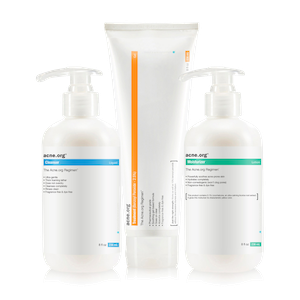 Acne.org Products
Acne.org Products